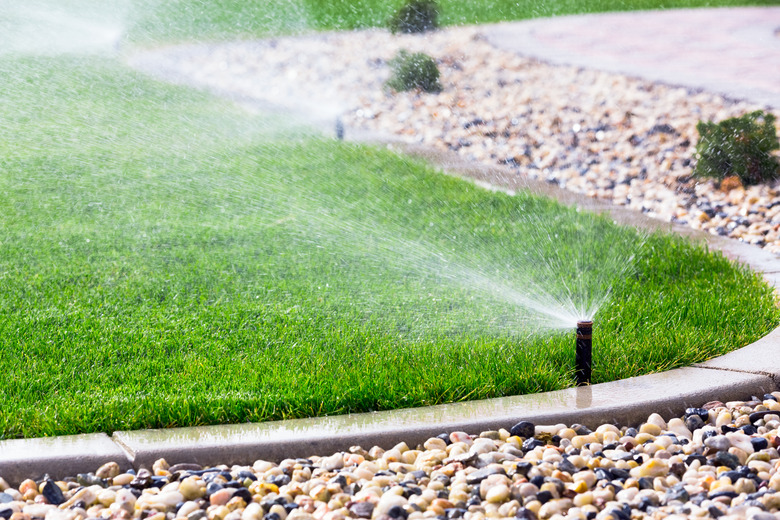How Often Should Grass Be Watered After It Is Fertilized?
Maintaining a healthy, green grass lawn involves so much more than simply mowing and weeding. Grass must also be carefully watered and fertilized to ensure healthy growth without the threat of damage, disease or insect infestation. Fertilizer itself can do damage to a lawn unless the watering before and after application is carefully controlled. There are a number of different factors that need to be considered to make sure this is done properly.
Tip
Once a lawn fertilizer is applied according to the package instructions, it should immediately be watered in; thereafter, grass can be watered as usual. Depending on rainfall, soil temperature and grass type, this usually comes out to be around an inch of water per week.
Watering After Fertilizing
Most fertilizers must be "watered in" in order to begin to absorb into the roots of the grass. This is especially important with granulated fertilizer. Without being watered in, fertilizer granules will just sit on top of the soil surface and dissolve into the soil slowly. In many cases this may not be enough to boost growth very well, if at all.
After you fertilize, water the grass lightly to help dissolve and activate the nitrogen, phosphorus, potassium and trace elements in the fertilizer that will promote healthy lawn growth. You should water so the fertilizer and soil become thoroughly moist, but not so the water begins to form puddles or wash away the nutrients. The actual amount of water needed will depend on temperature and the moistness of the soil.
Some Fertilizer Cautions
There are dangers with overwatering the grass after fertilizing. Obviously, you don't want to wash away the needed nutrients for your grass, but this can also present an actual danger other than simply wasting your fertilizer. Fertilizer carried away by excess water can contaminate groundwater and pollute nearby streams, ponds or rivers. This can lead to poisoning of wildlife or burning of plants from unexpected excess nutrients in the soil.
However, remember that if you do not water in your fertilizer you risk fertilizer burn from the nutrients sitting on the soil surface and grass blades and infusing the wrong areas with nutrients. So water, but do so carefully.
Ongoing Watering After Fertilization
After the initial post-fertilizer watering, avoid watering the grass for at least two to three days, so the nutrients can begin to work their way in. Aside from the initial watering in, you can return to your regular lawn-watering schedule.
Remember that it is best to water deeply and infrequently. Because of these guidelines, most gardeners and landscapers only water once a week, if that. The actual frequency will depend on rainfall, climate, the type of soil and the type of grass. As a general rule, grass needs about 1 inch of water per week.
Fertilizing and Watering Tips
The best time to either fertilize or water your lawn is in early morning, before the full heat of day comes on. This will reduce the chance of fertilizer burn, since the granules themselves won't be as hot on the surface.
Watering in the morning ensures that the water has time to absorb before it evaporates in the full heat of the day, but reduces the chance of disease setting in from lack of light and cooler temperatures associated with nighttime watering. You may want to set a timer if you have one you can use.
